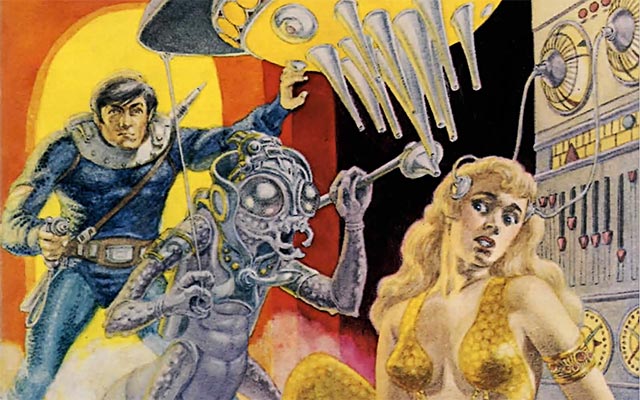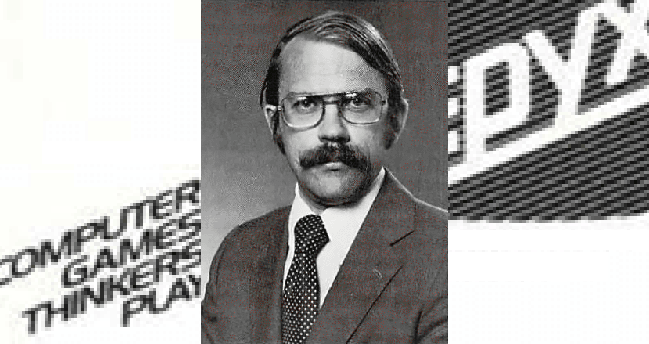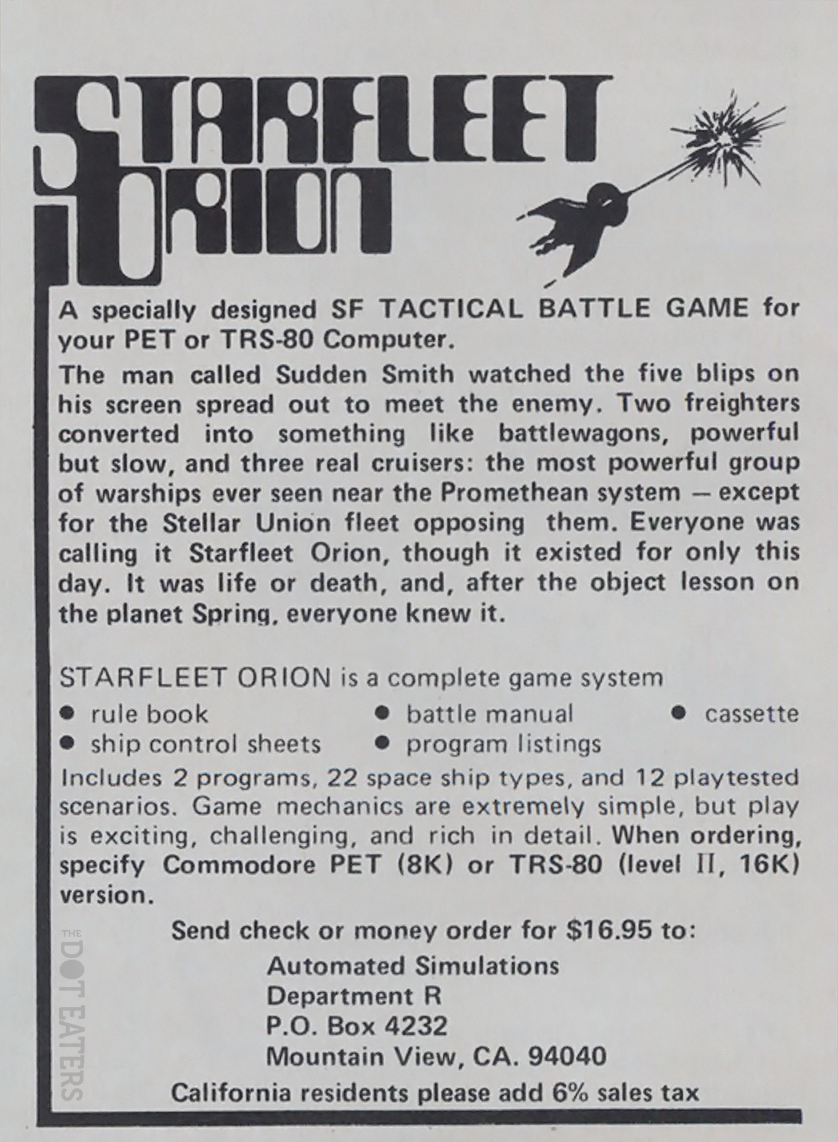Dungeon Calling
If there’s one thing that goes together with late 70’s computer users, it’s TSR’s paper and dice game Dungeons and Dragons. Jim Connelley is dungeon master of a running D&D game in California, and one of the regular players is Jon Freeman, a neophyte to computer programming but well-versed in game design. After receiving a Bachelor of Arts with honours in English from Indiana University and a master’s degree in English from the University of California, Freeman freelances as a writer. He has two books published under his name on the subject of games: The Complete Book of Wargames is published originally by Fireside in 1978, and later in 1980 by Simon & Schuster. The other is The Playboy Winner’s Guide to Board Games, released in 1979 by Playboy Press. This work appears to be a reissue of a book from 1975 titled A Player’s Guide to Table Games, from Stackpoole Books and credited to a “John Jackson”. Freeman is also a contributor to the hobbyist magazine GAMES. Having been interested in computer programming since being a math and physics major in college in the 60’s, Connelley picks up a newfangled Commodore PET computer after they come out in 1977. Looking to write-off the purchase, Connelley enlists Freeman’s help with designing Starfleet Orion, which Connelley programs in BASIC. When they finish it in December of 1978, they have the first space-based tactical combat game for a microcomputer. Connelley initially sells it through the mail and to friends and acquaintances, who push him to release the game commercially. In order to market the game, Connelley and Freeman form the first computer game publisher, Automated Simulations, operating out of each man’s spare bedroom in their houses in Mountain View, California. The game is followed by a sequel, Invasion Orion, also for the PET. Both games are a success and are eventually ported to other systems like the Apple II and TRS-80. An indication of the attitude the two founders have towards the type of games they want to produce is signalled by the company mascot, a stylized version of Rodin’s The Thinker holding a joystick, and the slogan ‘Computer Games Thinkers Play’.
With Freeman designing the games and Connelly as the main programmer, Automated Simulations really hits it big in 1979 with the first entry in its Dunjonquest series, Temple of Apshai. Heavily influenced by the two founder’s interest in D&D, the game is the first computer role-playing game (RPG), allowing character creation with six stats, divided into two sets: dexterity, strength, and constitution cover the physical aspect, with ego, intelligence, and intuition covering their mental state. Being a computer game, Apshai can do all the heavy lifting of probability calculations and weapons/armour modifications, leaving players to the fun of creating a character and getting on with the dungeon diving. After visiting the Innkeeper and rolling an alter ego, the player then stocks up on weapons, shield, and armour. An innovative aspect of play is the ability to haggle with the innkeeper, letting adventurers offer a slightly lower price for the equipment than the seller requests for it, in the hopes of saving a few coin on the deal. Once equipped, the player enters the Temple, populated by a variety of monsters, searching 200 rooms and catacombs for chests holding treasure.
Click button to play the original version of Temple of Apshai, on the Apple IIe
Featuring a sparse top-down display, the graphics are limited, with the rooms containing only a possible chest, guarding monster, and the bare walls. As the character is moved around the dungeon, the hallways open up to reveal new pathways and rooms, and players are directed to consult the 56-page manual, titled The Book of Lore, for immersive room descriptions and illustrations. These are written by Jeff Johnson, who also designs the dungeons for the game. Befitting the game’s close association with paper-and-dice RPGs, the manual also gives advice on how to convert your character from such a game to Dunjonquest, and how to take your experience and treasure back with you to the real world. To give players a sense of place in the Dunjonquest fantasy world, a short story titled The Adventures of Brian Hammerhand is also included.

You can see the influence of Flash Gordon and Buck Rogers in the cover for Epyx game Rescue at Rigel, 1980
Released after two months of intensive playtesting to get things balanced perfectly, Temple of Apshai goes on to win the Academy of Adventure Gaming Arts & Design’s Origin award for 1980’s Computer Game of the Year. Over 20,000 copies are sold of the game through 1981, for the Apple II, TRS-80 and the PET. In the wake of this success follows another entry in the Dunjonquest series, titled Hellfire Warrior. Featuring four new lower levels to Apshai, with over 200 rooms, ads for the game warn that beginners may not up for the challenge. The adventurings of Brian Hammerhand are also continued in Morloc’s Tower. Add-ons that require the original Temple of Apshai are eventually released: Lower Reaches of Apshai, Upper Reaches of Apshai and Temple of Ra. They are all adapted to every major game platform, including a C64 translation by Steve Bryson. The entire trilogy is re-released with improved graphics in 1985 in a package called The Temple of Apshai Trilogy. Other games produced in the early years of the company are Crush Crumble and Chomp, Starquest: Star Warrior, Keys of Acheron (expansion for Hellfire Warrior), Dunjonquest: Datestones of Ryn, and Starquest: Rescue at Rigel, among others… often released under the Epyx brand name, with another label, Mind Toys, used for puzzle and word games aimed at younger players. The brand name is originally to be “Epic”, to mark a goal of what quality of games the company was shooting for, but it has already been taken by Epic Records. Thus is the new name changed to Epyx, to make it sound a little more high-tech.
Click button to play Automated Simulations’ Crush, Crumble and Chomp on MS-DOS































Synapse and Epyx. The two best game publishers for the Atari 8 bit home computers in my opinion. I got my hands on every title I could that they put out with my limited chore/paper route money in the early 80’s.
For sure, they made some of the best games. I played them all on my C64.
Purple Saturn Day a game by EPYX sold here at an Alco Department Store was on Floppy disk for PC.
The year was 1999 I think ?
Interesting. I’ll assume that you mean “1989”, the same year that Epyx went into bankruptcy.
It sounds really interesting. Kind of a “Summer Games” in space. Or just “Space Games”, maybe. 😉
Thanks for reading and posting.